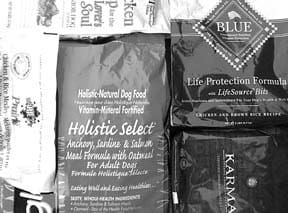by Nancy Kerns
How do you select your dog’s food? Do you buy what your favorite veterinarian tells you to buy? Grab whatever is on sale? Feed what your dog’s breeder sent him to you with? Allow your dog to sniff the bags in the pet supply superstore and choose the one he spends the most time with? For shame! None of these methods gives your dog his best chance at eating top-quality food.
Forthwith, we’ll tell you how we pick a winning food. We’ll list some examples of newer foods that meet our selection criteria – which we have refined over the six years that we’ve been reviewing foods – and present a list of all the foods that we have ever chosen to feature as a “WDJ approved food.” After all that, we expect you to be able to identify superior foods, and hope that you’ll see the wisdom in buying them.
WDJ’s selection criteria
Here’s how we select which dry foods are worthy of our dogs’ digestion (as well as a spot on our “approved foods” list): • We look for foods that contain a lot of animal proteins. Extruded food cannot contain more than 50 percent meat; it “gums up” the extruders. We like it when manufacturers tell us the approximate percentage of meat, poultry, or fish proteins in a food, but they rarely do. So we look for foods with lots of animal protein sources at the top of the ingredients list. Two animal proteins in the first three ingredients? Cool! Three in the top five? Right on! Two in the top five? Well, okay . . . Only one in the top five? That food better have a lot of other things going for it. (A good example is Karma, reputedly the first and only dry dog food on the market that is 95-100 percent organic.)
The thing is, we can’t reduce this to a hard and fast rule. When you look at the ingredients at the top of the list, note the relative position of the protein sources, the total amount of protein in the food, and consider your dog’s needs. Is he an elderly couch potato or a lean and active athlete? Keep all of this in mind.
Remember that ingredients are listed on the label by the total weight they contribute to the product. Fresh or frozen whole meats are expensive ingredients for the manufacturer, and tend to be a hallmark of quality. But whole meats also contain lots of water, which is heavy (pushing it toward the top of the ingredient list) but lacks nutrients. Meat meals are nutrient-dense. We have a somewhat baseless affection for foods that contain both whole meat (beef, chicken, fish, etc.) and meat meal (beef meal, chicken meal, fish meal, etc.).
• We reject any food containing meat by-products or poultry by-products. Note: Some of our past selections do contain meat and/or poultry by-products. To winnow down our list to the very best foods possible, we no longer select products that contain meat or poultry by-products.
By-products are not intrinsically bad; in fact, many are highly nutritious. However, by-products are less expensive, and are not always handled as carefully or quickly as more expensive foodstuffs. Poor handling or slow transport of these ingredients can decrease their palatability and nutritional content. Dog owners who are fixated on quality will find it easier to avoid foods that contain by-products than to confirm the quality of the by-products with the food manufacturer.
• We reject foods containing fat or protein not identified by species. “Animal fat” is a euphemism for a low-quality, low-priced mix of fats of uncertain origin. “Meat meal” could be anything. We shudder.
• We look for the use of whole grains and vegetables. That said, some grains and vegetables have valuable constituents that accomplish specific tasks in a dog food formula. So don’t go busting our chops because one of our approved foods has, say, tomato pomace ninth on its ingredients list; tomato pomace is used by some food makers for its contribution to the food’s fiber mix and for its lycopene content. Instead, focus your righteous indignation on a food that contains, say, rice flour, rice bran, and brewer’s rice, all in the top 10 ingredients.
Many dog food ingredients have gotten undeserved poor reputations – casualties of the “premium” foods marketing wars. It really depends how many fractions are used and which positions on the ingredients list they occupy. Look for an upcoming article about the relative value and uses of various vegetable and grain fractions.
• We eliminate all foods with artificial colors, flavors, or preservatives listed on their ingredients panels. Note: Some ingredients – usually fats, and some fish products – arrive at the pet food factory containing artificial preservatives; these do not have to be disclosed on the ingredient list, since the maker did not add them.
• We offer (fictional) bonus points for foods that offer the date of manufacture in addition to the usual “best if used by” date. The fresher the food is, the higher the nutrient content and palatability.
Each food manufacturer formulates their product to deliver adequate nutrition, without spoiling, for a specific length of time – usually, about 12 to 16 months. Factors that affect the functional “shelf life” of a food include the type and amount of preservatives used, the type of bag used, as well as the temperature, humidity, and exposure to light the product is exposed to in transport and storage.
We often recommend that consumers purchase food from outlets that assiduously manage their stock to ensure that the food on the shelves is relatively fresh. This is harder to do without that “born-on” date, but not impossible. If a food label has only a “best if used by” date, check to make sure that it’s as far in the future as possible.
• Organic ingredients bring a product to the front of the class, the more, the better.
Why quality matters
How many people do you know who can eat tons of highly processed, fatty, sweet, junk food – and are healthy, strong, and “balanced” in every sense of the word? Maybe a few, but these people are the exceptions. Similarly, some dogs can live forever on the junkiest, cheapest food sold in the grocery store. These individuals tend to be mixed breeds with hybrid vigor and fewer inherited propensities for disease.
But many of our canine companions are not so lucky. They may have a genetic predisposition for disease; every breed today is prone to at least a couple of emblematic diseases. Many dogs are often stressed out from our lifestyles. They endure exposure to a dizzying range of chemicals: pesticides, herbicides (a romp on the grass, anyone?), air pollutants from building materials in our homes . . . Just think of all the chemicals dogs walk on, barefoot, as it were, and then lick their paws.
We can do a little, but not a lot, to minimize the environmental toxins our dogs are exposed to. But we can give their bodies the nutrients they need to eliminate toxins, build immune defenses, and improve overall health and vitality. We accomplish this by feeding them the equivalent of “health food” – a diet comprised of the freshest and best ingredients possible.
Of course, the best way to accomplish that is to prepare your dog’s diet from fresh, whole foods, the same kind you eat. We frequently publish articles on how to do just that. But those of you who can’t or won’t make your dog’s food can improve matters just by upgrading the dog food you buy.
Prove it!
As with the canned food review we published in December, we tried something new with this installment of our dry food review. We asked most (we missed three) of the companies on our past “Top Food” lists to provide information about their manufacturing operations and ingredients.
First, we asked them to tell us where their foods are made, and we asked them whether they disclose this information to their consumers. As we discussed in “Made in a Secret Location” (January 2003), most pet food companies don’t like revealing anything about their manufacturing operations.
We also asked them to provide us with documentation to substantiate any special claims they make about their ingredients. If they say they use organic ingredients, we wanted to see organic certification documents. If they hint that they use “human grade” ingredients (we’ll discuss that in a second), we asked to see USDA certificates.
“Human grade”
We discussed the phrase “human grade” at greater length in our canned food review in the December 2003 issue. Technically, legally, NO pet food in this country contains ANY “human grade” ingredients. This is understandably frustrating for the manufac-turers who buy truckloads of the exact same chicken and beef and rice that go into your tacos. Suffice to say there are reasons for this regulatory conundrum.
What’s a premium food maker to do? Some manufacturers toe the line on their product labels, but openly refer to their “human grade” ingredients in their product literature and Web sites, in somewhat less-than-open defiance of the law. Others take a modulated approach and say their ingredients “originated” in USDA plants. (That lamb’s mother might disagree, but we know what they mean: “human grade”.)
With no further ado, check out the new foods listed below, and compare it to your dog’s food . . . Ready to switch?
Also With This Article
Click here to view “Toxins That Can Arise in Dry Dog Food”
Click here to view “How to Compare Nutrient Levels in Canned Dog Foods with Dry Foods”
Click here to view “Dry Dog Food Can Expire and Make Your Dog Sick”






